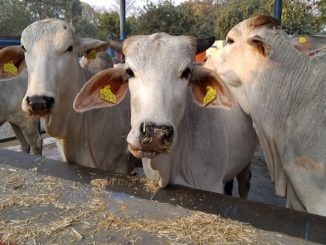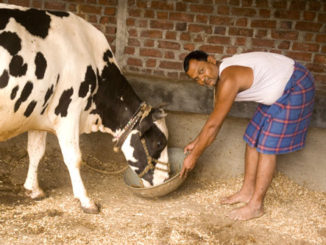Feed and fodder are the important input for dairy and poultry industries. Due to cost of feed and fodder the merging of profit going down day by day to farmers and also due to famine conditions. Severe depletion of groundwater day by day makes farmer to search the alternate source of feed and fodders to animals.
Azolla a blue green symbiotic algae Anabina azolle, a floating fern , which is responsible for the fixation and assimilation of atmospheric nitrogen. Species of Azolla are found they are Azolla maxicana,Azolla microphylla,Azolla nilotica,Azolla caroliniana,Azolla filiculioides, among these Azolla pinnata, Azolla filiculoides are important as livestock feed.
Cultivation of azolla
Better it should be cultivated in the backyard of house or dairy shed or poultry shed. Generally direct sunlight exposure not advised for azolla cultivation. Tree shed or green shade net should be used as a roof for the azolla pond.
An area of 6×4 feet Azolla cultivation plot can produces 1 kg of azolla per day. Depth about 15 to 20 cms made on the ground and it’s covered with polythene sheet so that water should not absorbed from the ground and stagnate on the polythene sheet.Better to put 2 layers of Polythene sheet for long term storage of water.Care should be taken in such a way that at any time 10 cm @ more should be present in the pond.Then add fresh cow dung in the pond about 2-3 kg, 100-200 gms of Super phosphate & mix properly in the water, to be repeated every 15 days.Add 250 gm of fresh Azolla culture to the pond & allow for grow. Bricks or stones are used in the edge as weight source for polythene sheet.Regular monitoring is necessary to check the growth.Then the pond will be complete by the growth of Azolla and 1kg of yield can expect per day basis.Based on number of animals/birds & need of Azolla per day farmers can plan size of pond for more yield. Azolla will double its bio mass in 10 days.
Feeding of Azolla
Azolla can be fed solely in poultry.Before feeding it should be washed properly to remove the smell of cow dung.For feeding in cattle it should be mixed with the 1:1 ratio with concentrates. Azolla is feed for Cattle, Swine , Rabbit & Poultry.
Advantages of feeding of azolla
- Azolla can be grown in any season; azolla is rich in minerals like calcium, phosphorus, potassium, iron, copper, magnesium etc.
- Azolla having 25 to 30 % of protein and low Lignin makes digestible to livestock and poultry.
- Azolla feeding will increases milk yield in cow by 15 to 20 %.
- Azolla has nutrients which are similar to commercial feed of poultry, azolla rich source of vitamin A, beta carotene, vitamin B12, growth promoters and some phytosterols it’s also known as green gold.
- Azolla feeding will increases number of egg production and good quality of yolk production in layers.
- Azolla feeding will improves body weight and weight gain in broilers.
- Azolla is palatable and easily digested by livestock and poultry.
- Azolla feeding improves the quality of milk, meat, health and longitivity of livestock.
- Azolla is highly digestible due to low Lignin and high protein.
- Azolla more economical and efficient feed stuff during remind conditions due to easily cultivable and having fast growth.
- Azolla has almost all essential amino acids, probiotics and bio polymers.
- Azolla has very low carbohydrate and Oil content so it’s good for ruminant animals.
- Azolla has 25.78% crude protein, 15.7% crude fiber, 3.47% of ether extract, 15.76 % of ash & NFE about 30.08%
- Azolla can replace 20% of commercial feed in chick feed.
- Azolla easy to grow & economical.
- It has ability to proliferate without inorganic nitrogen fertilizer.
Other important role of Azolla
- Weed control.
- Mosqito control.
- Herbicide.
- Bioremediation.
- Nitrogen fixation &green manure.
Chemical composition of Azolla: The chemical analysis indicated that Azolla meal contained
- Crude protein-21.4%
- Crude fibre-12.7%
- Ether extract-2.7%
- Ash-16.2
Carbohydrate-47%. And a gross energy value of 2039 kcal kg obtained. The concentration of calcium, phosphorous, potassium and magnesium are respectively 1.16%,1 .29%, 1.25%, 0.25% sodium, manganese, iron, copper and zinc are 23.79 ppm, 174.42 ppm, 755.73 ppm, 16.74 ppm and 87.59 ppm respectively. The chemical score index showed the potential of Azolla meal as good source of protein. Leucine, lysine, arginin were the predominant essential amino acids while tryptophan and the sulphur containing amino acids were deficient.
Demerits of azolla
- Water is pre requisite in its multiplication so it is not suitable for upland crop.
- Huge quantity of inoculum is required which is difficult for transporting action during rainy days.
- Temperature more than 35c is not suitable.
- Extreme low temperature is also not suitable.
- Initial cost of cultivation is high but yield is low.
- Availability of nutrients to plants is not instant.
- Market for Azolla is not popular.
- Ignorance of people about benefits of azolla.
Conclusion
By seeing easy cultivation and low input for cultivation and based on the chemical composition of Azolla it could be concluded that use of azolla as a conventional feed for livestock and poultry is best for getting good performance from livestock and poultry.






Nice article
Very useful article
Nice article sir
very useful article.
Very nice and useful article.
Good informative article
Good article…
Very good and usefull article..
very nice article hk
Good information doctor
Useful for farmer, nic article
Very useful article..
Very nice article for farmers and veterinarians…Now a days feed is big issue in livestock sector… Nicely explained…..
Good article
Good one
Very nice article
Good attempt